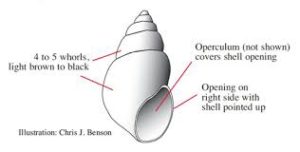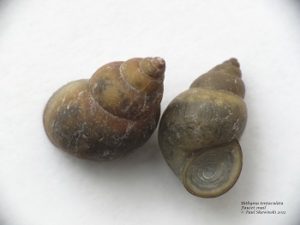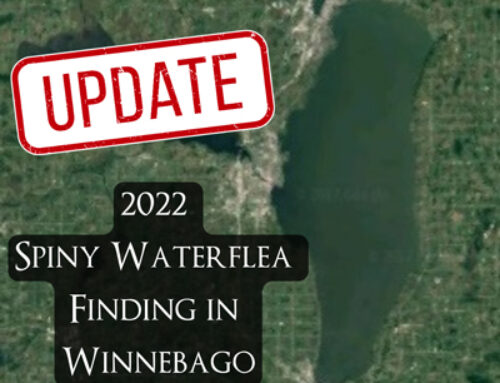A Snail Like Any Other? Not Quite
The Faucet Snail (Bithynia tentaculata) may look like any other snail you find in the Winnebago Waterways, but underneath the coiled shell lies an animal that can have major impacts on our waterways.

Picture from Minnesota Sea Grant
Faucet snails were first found in the Great Lakes in the 1870s and first documented in Lake Winnebago in 2013. Native to Europe, the faucet snail most likely reached North America through sediment used for solid ballast (the precursor to ballast water that is used today) or in contaminated vegetation used in packing crates. These snails reach high densities and can out compete native snails for resources such as food and space.
Faucet snails have brown shells and are on the smaller size: 1/2 inch long when fully grown! Their shells have 4-5 whorls with an opening on the right hand side when the shell is pointing up. One of the features that makes these snails successful when hitchhiking on recreational equipment is the operculum. An operculum is made up of layers of calcium carbonate that acts as a trapdoor. It creates a seal that traps water inside the shell and provides protection to the snail.

Picture from Minnesota Sea Grant
This species eats algae that grows on substrates like rocks, sticks, and other larger plants but is also able to filter feed by sucking in algae from the surrounding water and eating it (similar to zebra mussels). As a sexual species, faucet snails need both males and females to reproduce and create a sustainable population. The females lay their eggs on rocks, wood, or larger shells in clumps of 1-77 eggs. Egg clumps have been found in  some areas of the United States to reach densities of 155 clumps/m2! Eggs tend to hatch in as little as three weeks or up to three months depending on conditions. In general, faucet snails live for three years.
some areas of the United States to reach densities of 155 clumps/m2! Eggs tend to hatch in as little as three weeks or up to three months depending on conditions. In general, faucet snails live for three years.
Like many other invasive species, the small size of the faucet snail allows it to remain undetected and hitchhike from one waterbody to another by attaching to boats, anchors, aquatic plants, decoy anchors, and other recreational equipment. The snail is also able to close itself behind its operculum allowing them to survive out of water for days!
Impacts
While it may seem hard to fathom, these tiny snails can have a large impact on our waterways! The faucet snail has been documented to decrease the abundance of native species in several locations throughout the U.S. such as the Erie Canal and Oneida Lake. These snails also like to infest municipal water supplies to such an extent that it has been found sliding out of water faucets in its native range – that’s where the faucet snail gets it’s name! The biggest impact of the faucet snail is seen in the large scale waterfowl die-offs from birds that eat the snails including coot and scaup. Faucet snails are the host for several trematode parasite species. When waterfowl eat infected faucet snails, the trematodes infect the birds which causes them to die in three to eight days. In the Upper Mississippi River it is estimated that more than 70,000 waterfowl have died from the parasitic trematode species after eating infected faucet snails.
Want to help? HELP PREVENT THE SPREAD!
Every time you come off the water, make sure to follow these steps to stop the spread of faucet snails and other aquatic invasive species:
* Inspect boats, trailers, push poles, anchors, and other equipment for attached aquatic plants or animals.
* Remove all attached plants or animals
* Drain all water from boats, motors, livewells and other equipment
* Never move live fish away from a waterbody
* Never release aquarium plants or animals into your local waterways
Follow the Fox Wolf Watershed Alliance’s Winnebago Waterways Program on our Winnebago Waterways Facebook page or @WinnWaterways on Twitter! You can also sign-up for email updates at WinnebagoWaterways.org.
This article was written by Chris Acy, the AIS Coordinator for the Winnebago Waterways Program covering Fond du Lac, Calumet, and Winnebago Counties.
Questions? Comments? Contact Chris Acy, our Aquatic Invasive Species Coordinator at (920) 460-3674 or chris@fwwa.org!
Winnebago Waterways is a Fox-Wolf Watershed Alliance program. The Fox-Wolf Watershed Alliance is an independent nonprofit organization that identifies and advocates effective policies and actions that protect, restore, and sustain water resources in the Fox-Wolf River Basin.





